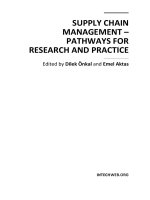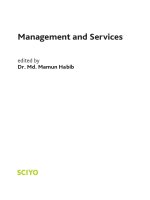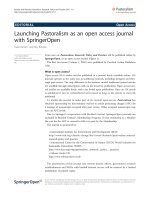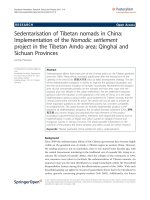Kerven and Behnke Pastoralism: Research, Policy and Practice 2011, 1:1 docx
Bạn đang xem bản rút gọn của tài liệu. Xem và tải ngay bản đầy đủ của tài liệu tại đây (604.76 KB, 5 trang )
EDIT OR I A L Open Access
Launching Pastoralism as an open access journal
with SpringerOpen
Carol Kerven
*
and Roy Behnke
* Correspondence:
Odessa Centre Ltd, Warwickshire,
UK
From now on, Pastoralism: Research, Policy and Practice will be published online by
SpringerOpen, as an open access journal (Figure 1).
The first two issues (Volume 1, 2010) were published by Practical Action P ublishers
(UK).
What is open access?
Open access (OA) makes articles published in a journal freely available online. OA
journals operate in the same way as traditional journals, including stringent and thor-
ough peer-review. The only difference is the business model: traditional journa l articles
are available through subscription, with no fee levied for publication. Open access jour-
nal articles are av ailable freely, with a fee levied upon publication. Once an OA article
is published it can be redistributed and reused as long as the article is correctly
attributed.
To enable the journal to make part of its content open access, Pastoralism has
obtained sponsorship for discretionary waivers to article processing charges (APC) for
a number of manuscripts accepted after peer review. Other accepted manuscripts may
have an APC levied.
Due to Springer’s cooperation with BioMed Central, SpringerOpen journals are
included in BioMed Central ’ s Membership Program. If your institut ion is a Member
the cost for the APC is covered in full or in part by the Membership.
The journal is sponsored by:
• International Institute for Environment and Development (IIED)
/>research-policy-and-practice
• International Union for the Conservation of Nature (IUCN) World Initiative for
Sustainable Pastoralism (WISP),
/>• Odessa Centre UK.
/>The penetration of this journal into remote district offices, government research
establishments and NGOs with limited internet access, will be ensured by a limited
distribution of printed copies.
Kerven and Behnke Pastoralism: Research, Policy and Practice 2011, 1:1
/>© 2011 Kerven and Behnke; licensee Springer This is an Open Access article distributed under the terms of the Creative Commons
Attribution License ( which permits unrestricted use, dist ribution, and reproduction in
any medium, provid ed the original work is properly cited.
In Volume 1 published by Practical Action Publishing (UK) Issue 1 was on “Mobile
Pastoralism in the Industrial World”, with case studies from western USA, Australia,
Romania, Spain, France and Brazil, as well as two book reviews. Issue 2 contained
articles focussed on southern Africa, Siberia, western China, Tajikistan, Ethiopia and
Patagonia. This issue a lso contained a note on research in progress on the Tibetan
plateau and two book reviews.
Who will be the Journal’s contributors?
Pastoral ism, incorporating ranching, refers to extensive livestock production mainly on
natural pastures and is a global phenomenon. From the semi-arid tropics to the Arctic,
Pastoralism
Research, Policy and Practice
Figure 1 Cover for the SpringerOpen Journal.
Kerven and Behnke Pastoralism: Research, Policy and Practice 2011, 1:1
/>Page 2 of 5
it is practiced in environments as varied as deserts and savannahs, marshes, high mea-
dows, plains and tundra. By sourcing material worldwide, Pastoralism promotes the
comparative analysis of this varied and widespread production system throughout the
world.
The journal publishes research and field experience that influences policy and prac-
tice, to improve the welfare of pastoral people, better conserve the environments in
which they live, and c ontribute to broad economic development. Pastoralism is com-
mitted to publishing material not just by researchers but also by administrators and
field workers who would not normally contribute to a scientific journal.
Who will be the Journal’s readers?
After the first issue of the Journal was published in September 2009, our sponsors IIED
and IUCN WISP placed announcements in their emailed bulletins and websites, and
flyers were distributed by Odessa Centre. A number of people registered to receive
information about the jou rnal, on t he WISP website, or by contacting I IED or the
editors at Odessa Centre.
There are several remarkable features shown by the geographical locations of those
who had registered their interest in the Journal by late 2010.
Africa 50%
Europe 23%
Asia and Australia 11%
North America 10%
Latin America 6%
Half the re gistered readers were based in Africa, and nearly one third (29%) of all
readers were based in only two countries: Kenya and Ethiopia.
There is a discrepancy between the geographical distribution of those who initially
expressed interest in the Journal and the actual dispersion of pastoralists in the devel-
oping world. An analysis of a report by the International Livestock Research Institute
ILRI (Thornton et al. 2002), in Table 1 s hows the r egional distribution of people
defined by I LRI as livestock-dependent and rangeland-based in parts of countries
which are arid/semi-arid, humid/subhumid or temperate/tropical highlands. Of the
Table 1 Regional breakdown of pastoralist populations in developing world
REGION Millions %
West Asia, excluding N. Africa 31.1 17
East Asia, inc. China 21.6 12
South Asia, inc. Pakistan and India 19.3 11
Ex USSR 8.2 5
South East Asia 1.4 1
sub-total 81.6 46
Sub-Saharan Africa 61.9 34.3
North Africa 5.1 2.8
sub-total 67 37
Central and South America 32.1 18
TOTAL 180.7 100%
Source: Thornton et al. 2002.
Kerven and Behnke Pastoralism: Research, Policy and Practice 2011, 1:1
/>Page 3 of 5
total 39 of these countries, 18 (46%) have no representatives among the Journal’s regis-
tered r eaders. The countries with the largest pastoral populations, i.e. China , Pakistan,
Brazil, Yemen, Sudan, Iran, Somalia etc. are presently very poorly represented among
the Journal readers. ILRI’s compilation of livestock data in 2002 did not include
“northern” or d eveloped rich countries of western Europe, Russia, North Amer ica,
Australia, Japan etc. Classifications change as countries grow richer, and the BRIC
countries of Brazil, Russia, India and China would not now be classified as developing,
but Brazil, India and China are included in the ILRI 2002 data base (Thornton et al.
2002), while Russia was not.
The majority of pastoralists (45%) are found in Asia (including the Middle East), spe-
cifically in China, Pakistan, Iran, Yemen, Saudi Arabia, Afghanistan and Kazakhstan, as
well as other countries. However, only 11% of jo urnal readers are so far based in Asia,
and a negligible amount from Latin America. It is therefore clear where we need to
recruit new readers and co ntributors. With the transition to SpringerOpen, those who
wish to read the journal no longer need to subscribe, pay or sign up. Readers can set
up email alerts on SpringerOpen to be informed when a new article is published online
in Pastoralism journal. This is an imp ortant new channel for widening the representa-
tiveness of our Journal.
There are also pastoralist populations in developed countries, and one third of o ur
currently- registered readers are based in Europe, USA and Australia. In recognition of
this, the editors have solicit ed a series of research and policy articles on pastoralists in
former socialist eastern and southeastern Europe, which will appear soon in the
Journal.
Research articles now published on line
Here we briefly introduce the first group of research papers launched on the Springer-
Open online website. There are five papers all set in Asia, spanning not only very dis-
similar environments and peoples - mountains and deserts of Pakistan, tropical plains
of In dia, cold desert Tibetan plateau - but including a paper on the pre-history of pas-
toralism in the Eurasian steppes. This assembly of papers well represents the broad
concerns of the Journal, with contributions from practitioners as well as academics,
and covering diverse disciplines from animal science, archaeology, forestry, geography,
grassland science, socio-economics, and veterinary science.
Several general points arise from these articles. Two of the papers (Kumar et al. and
Ptackova) discuss the consequences of sedentarisation - settling down of previously
mobile pastoralists. In a case from the southern India semi-arid grasslands, over a cen-
tury and half former mobile pastoralists acquired secure land rights and have sponta-
neously developed a form o f rotational grazing, using live fences and supplementary
feeding, which results in a stable form of settled pastoralism. The Tibetan nomads of
western China are only now being settled through government-sponsored programmes,
and are losing their communal grazing land rights while gaining modern housing and
social benefits. The consequences for their pastoralist production and social systems
are as yet barely known.
The paper by ur-Rahim et al. about a region in the Hindu Kush mountains of
Pakistan draws out the entangled effects of government forestry interventions and
central government land tenure reforms on political control, inter-ethnic relations and
Kerven and Behnke Pastoralism: Research, Policy and Practice 2011, 1:1
/>Page 4 of 5
access to fodder trees by multiple different user groups. The introduction of exotic tree
specie s and transference of property usage rights from mobile pastoralists to sedentary
landlords has left mobile pastoralists the losers. The authors offer practical recommen-
dations for re-introducing nutritionally-valuable indigenous fodder tree species.
In the hot dry plai ns of Pakistan, several pastoralist groups raise two breeds of
camels, each w ith distinctive physiological and economically important attributes - for
racing, milk ing, meat and transport. The paper by Kakar et al. provides a description
of these two breeds, and argues that the breeds are under threat as their pastoralist
owners are losing access to grazing lands due to encroachment of irrigated cotton and
cereal farming by wealthy outsiders to this desert region. The authors end by propos-
ing development measures which could uphold the role of the camel breeds and
support the pastoralist societies.
Pastoralism has deep roots into pre-history, w hich can only be unders tood through
archeological investigations, as shown in the paper by Bendrey. In one of the geogra-
phical origins of pastoralism - the Eurasian steppe - there is great variability in the
environmental and biological factors which can affect the predominance of the main
domestic livestock species of cattle, sheep/goats and horses. The author concludes that
“comparison of the later prehis toric animal bone assemblages and the modern and his-
toric livestock herd compositions show a number of consistencies indicating the
strong influence of the environment on the pastoral economies practiced across the
Eurasian steppe”.
In this collection of research articles, while one paper (Bendrey) informs us about the
origins o f pastoralism in Asia many millennia ago, another ( Ptackova) tells us about
the probable extinction of at least one pastoral mode - Tibetan nomads in China -
which is happening right now.
Inam-ur-Rahim, Daniel Maselli, Henri Rueff, Urs Wiesmann, Indig enous fodder trees
can increase grazing accessibility for landless and mobile pastoralists in northern
Pakistan
Abdul Raziq Kakar, Kerstin d e Verdier and Muhammad Younas, Rapid change of
strategy is necessa ry for developm ent of dromedary camel pastoralism in the Cholistan
desert of Pakistan
Jarmila Ptackova, Sedentarisation of Tibetan nomads in China: Implementation of the
Nomadic settlement project in the Tibetan Amdo area; Qinghai and Sichuan Provinces
Robin Bendrey, Some like it hot: environmental determinism and the pastoral econo-
mies of the later prehistoric Eurasian steppe
Anil K umar, S. Natarajan, N.B. Biradar and B. K. Trivedi, Evolution of sedentary pas-
toralism in south India: case study of the Kangayam grassland
Received: 8 April 2011 Accepted: 9 May 2011 Published: 9 May 2011
Reference
Thornton, PK, RL Kruska, N Henninger, PM Kristjanson, RS Reid, E Atieno, AN Odero, and T Ndegwa. 2002. Mapping Poverty
and Livestock in the Developing World. Nairobi: International Livestock Research Institute.
doi:10.1186/2041-7136-1-1
Cite this article as: Kerven and Behnke: Launching Pastoralism as an open access journal with SpringerOpen.
Pastoralism: Research, Policy and Practice 2011 1:1.
Kerven and Behnke Pastoralism: Research, Policy and Practice 2011, 1:1
/>Page 5 of 5









